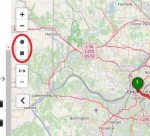
In The Wizard of Oz, Dorothy’s mantra is “There’s no location like home, there’s no place like house”, and the whole motion picture is basically about her following a yellow brick road to arrive. Many of us spend an excellent chunk of our lives far from house, whether it’s at work, on getaway, visiting family or friends, or just going on an outdoor camping, searching or fishing trip. If you spend any amount of time more than a couple of miles (or kilometers) far from your home or bug-out area (BOL), there’s a chance that an emergency or catastrophe may strike while you’re away, needing you to travel your own personal yellow brick roadway to return. While there have actually been a variety of posts by myself and others in SurvivalBlog.com about kitting out a Get Home Bag (GHB), less attention has been paid to preparing how you would get back to your home or BOL. The function of this post is to offer some ideas and assistance to assist you plan your journey home from wherever you might be when disaster strikes.
Documents
Unless you’re blessed with an eidetic memory or you only ever travel to one of two nearby areas, you’re going to need some method of creating, keeping, organizing, and upgrading get-home path plans. I highly advise Joplin, which is a totally free open-source note-taking tool that supports formatted text, embedded images, attached files, and numerous other features, and is readily available for Windows, macOS, Linux, Android and iOS. It also supports synchronization of all notes (and thus your path strategies) in between several devices utilizing a wide variety of cloud services. This enables me to develop and handle my get-home path plans on my desktop and quickly gain access to them on my mobile phone when I’m on the roadway.
Keep in mind that once you have actually produced a path strategy you’ll require to run Joplin on your mobile device to integrate a local copy, which you’ll want to do prior to you start traveling, given that Internet gain access to will probably be among the very first things to go in numerous catastrophes. I have a Nextcloud individual cloud service working on a Raspberry Pi on my home network for synchronizing Joplin (to name a few things), so I don’t need to stress over anybody else reading my notes, and Joplin also supports strong end-to-end encryption to protect my information in transit. I have actually produced a Joplin design template that I use each time I produce a brand-new path plan; it has actually predefined areas for whatever I wish to cover.
The other nice thing about Joplin is that it has an excellent print function, so you can print off a hardcopy of your get home route plan to take with you in case we’re hit with an EMP and all of the electronic devices are down. I usually print hardcopies of any routes that I might require on a regular basis, and coat them with AquaSeal map sealant or utilize a DIY approach to safeguard them. Additionally, you can print them off and save them in a waterproof map pouch or large ziplock baggie to secure them till you need them. In order to lower weight and bulk I print my path prepares double-sided in color on 8.5″ x 11″ (A4) paper utilizing a quality printer and fresh ink cartridges.
Route Planning Software
The first thing I do is strategy my preliminary path– this is my proposed route with no possible risks, barriers, weather condition, and so on taken into consideration. My tool of preference is the Open Path Service (ORS), which is an online open-source path preparation tool. I altered the map source to OpenStreetMaps (OSM) and the units to miles– click the best arrow on the left side of the screen, click the gear icon, broaden ‘Map view and extra details’, then select ‘OpenStreetMap’ as the tile company and ‘Miles’ as the units, however you can set it up any method you desire. You might also use industrial offering like Google Maps or Bing Maps, however they do not have one feature that we’ll use later– the ability to export a GPX track file, which is a list of lat/long coordinates that specify the path which can be imported into mapping software application on your mobile device. A lot of business online mapping tools likewise collect a great deal of information about you and your activities, so I attempt to restrict that as much as possible.
Like the majority of map routing services, ORS has the capability to pick in between driving, strolling, biking and mass transit for your path, and offers some extra choices for each. For instance, there’s routine walking and hiking, on-road cycling vs. mountain biking, and so on– you can pick the one that works best for you, or simply leave the defaults.
I tend to do all of my route prepares as both walking/hiking and cycling, on the presumption I may be able to acquire a bicycle instantly after a possibly vital situation emerges that requires me to get home ASAP (I carry a bunch of emergency situation cash, and include the addresses of local bike stores in my preparation). If you’re going to be a long distance from house you may wish to consider acquiring a bike with a small trailer before beginning, as this would permit you to quickly bring more equipment. You can also intend on having an automobile to drive home, however I believe there are a lot of scenarios where that would be difficult if not impossible and I wish to be gotten ready for a worst case.
ORS offers a couple of features that are very beneficial for get-home route preparation– the ability to by hand alter the route, and the ability to exclude locations from path planning. To manually change the route you simply move your mouse over the path and drag the white box that appears to the point you wish to include on your path. ORS will re-calculate the route to take you through the point you dragged it to. Exclusion zones offer you the capability to define an area you want to avoid; there are 2 methods for doing this– a rectangle or a polygon. The 2 tools on the maps are circled in the following photo:
 The leading one is the polygon tool– click on the tool, then click a series of indicate confine the location you want to prevent; when you’re done, click back on the first point and ORS will draw a blue polygon and change your path to avoid that area. The rectangular shape tool is similar, but you click it, then click and hang on one corner of the zone and drag the pointer to the opposite corner. When you release the mouse button it will fill in a blue rectangular shape and route you around it. You can erase any exemption zone by clicking straight inside it and clicking on the garbage can that appears. Here’s an image of a sample for a strolling path from downtown Cincinnati, Ohio to Camp Dix, Kentucky, with a small rectangle-shaped exclusion zone near Marysville, Kentucky that simulates a place where dangerous chemicals may be saved:
The leading one is the polygon tool– click on the tool, then click a series of indicate confine the location you want to prevent; when you’re done, click back on the first point and ORS will draw a blue polygon and change your path to avoid that area. The rectangular shape tool is similar, but you click it, then click and hang on one corner of the zone and drag the pointer to the opposite corner. When you release the mouse button it will fill in a blue rectangular shape and route you around it. You can erase any exemption zone by clicking straight inside it and clicking on the garbage can that appears. Here’s an image of a sample for a strolling path from downtown Cincinnati, Ohio to Camp Dix, Kentucky, with a small rectangle-shaped exclusion zone near Marysville, Kentucky that simulates a place where dangerous chemicals may be saved:
Note that ORS restricts the size of exclusion zones, so for a bigger location like city you want to avoid you might need to develop numerous smaller zones, or drag the route around the areas you do not want to go.
ORS likewise provides various map ‘layers’ that reveal different kinds of maps– I tend to use the default OpenStreetMaps, however there are satellite imagery, topographic maps, etc. The icon in the upper right-hand corner that appears like three sheets stacked on top of each other allow you to change in between the various layers. Satellite images is useful for identifying wilderness areas you can use for taking breaks or sleeping.
Another indicate remember with any of the path preparation website and applications is that when you select strolling for your transport mode, they won’t route you anywhere you’re not permitted to walk under normal conditions. I’ve done walking plans where ORS paths me miles out of the way to avoid strolling a number of hundred feet on a highway, so you’ll need to keep in mind there might be options offered, depending on the scenario. After a major disaster a lot of existing safety guidelines will probably become less crucial, and you more than likely will not get in problem for treking along the side of a highway if there are no cars and trucks running.
Alternate Route Options
While many route-planning applications (consisting of ORS) presume you’re completely pleased strolling along sidewalks and other public paths, there might be situations where you choose to avoid obvious paths like roads as much as possible while you’re making your method house. There are a couple of alternatives for more discreet travel paths that you may wish to consider, like hiking tracks, railroad tracks, and power line right-of-ways.
Hiking tracks offer one excellent option to public roadways and methods. There usually won’t be a great deal of folks hiking after a significant disaster, and a great deal of the routes are well-documented and marked. The good news is that when you pick ‘Foot Hiking’ as the mode of transportation in ORS, it will immediately route you through treking tracks if they’re offered. Note that this may not constantly be the fastest route– here’s an example:
Say you live in Yakima, Washington and you’re going to Eugene, Oregon when catastrophe hits and you understand you need to walk home. Here’s the path ORS determines if your mode is set to ‘Foot Hiking’:
And here’s the same route strategy other than for the mode being set to ‘Foot Walking’:
The Hiking path has
you following the Pacific Crest Path for the majority of the trip, however it’s around 60 miles(97 km )longer. You’ll need to stabilize your perceived requirement to maintain a low profile with possible time and range tradeoffs. If you do choose to incorporate treking routes you can quickly recognize them as dotted lines on ORS, and there are a great deal of sites that can supply you with additional details on things like shelters, camping sites, water sources, and so on that you can discover along the trail. Here are a couple of: Numerous states and nations offer comprehensive online maps of their treking
trails and campsites, and in the US, REI shops generally have an excellent selection of paper maps for many local and nationwide hiking tracks.(To be continued tomorrow, in Part 2.)




